BUS7007D Quality Management: A Comparative Analysis of Tesla and Honda
VerifiedAdded on 2023/04/20
|16
|4228
|370
Report
AI Summary
This report provides a comprehensive comparison of Tesla's and Honda's quality management systems, evaluating their evolution, strategic importance, and the tools and techniques they employ. The report begins by examining the historical context of both companies, highlighting Honda's early adoption of total quality management and Tesla's more recent approach. It then delves into a detailed analysis of their respective quality management systems, including the use of CAPA, APQP, and FMEA tools. The report contrasts Honda's emphasis on factory flexibility and human involvement with Tesla's drive towards full automation. The study assesses the strategic importance of quality management for Tesla, particularly in the context of its premium product offerings and mass-market ambitions. Ultimately, the report highlights the differences in the quality of products offered by each company, and concludes that Honda has developed an innovative and flexible quality management system which facilitates in managing their sustainable competitive advantage effectively. The report is based on the BUS7007D Quality Management assignment, and concludes with a discussion on the significance of quality management in retaining customers.
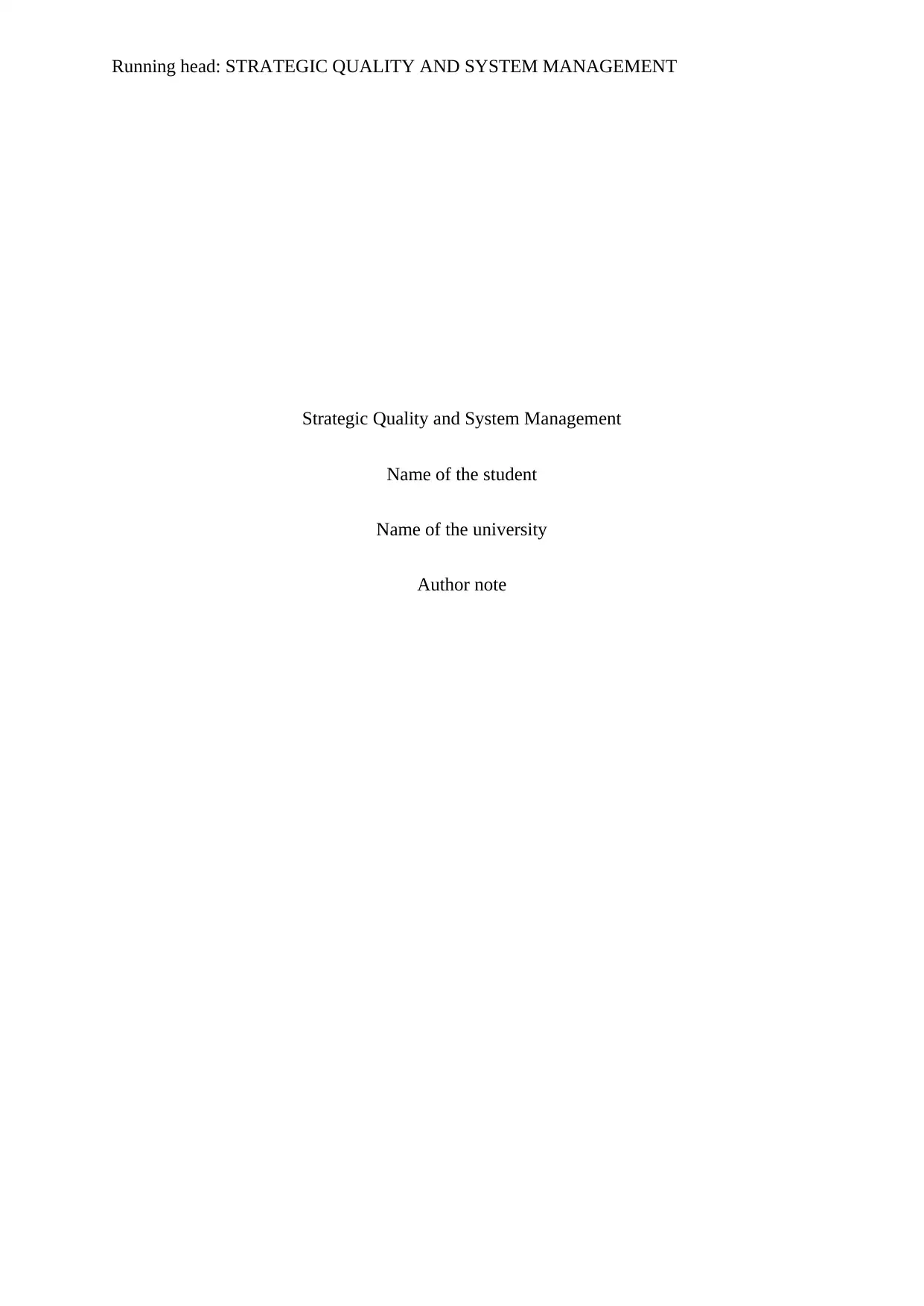
Running head: STRATEGIC QUALITY AND SYSTEM MANAGEMENT
Strategic Quality and System Management
Name of the student
Name of the university
Author note
Strategic Quality and System Management
Name of the student
Name of the university
Author note
Paraphrase This Document
Need a fresh take? Get an instant paraphrase of this document with our AI Paraphraser
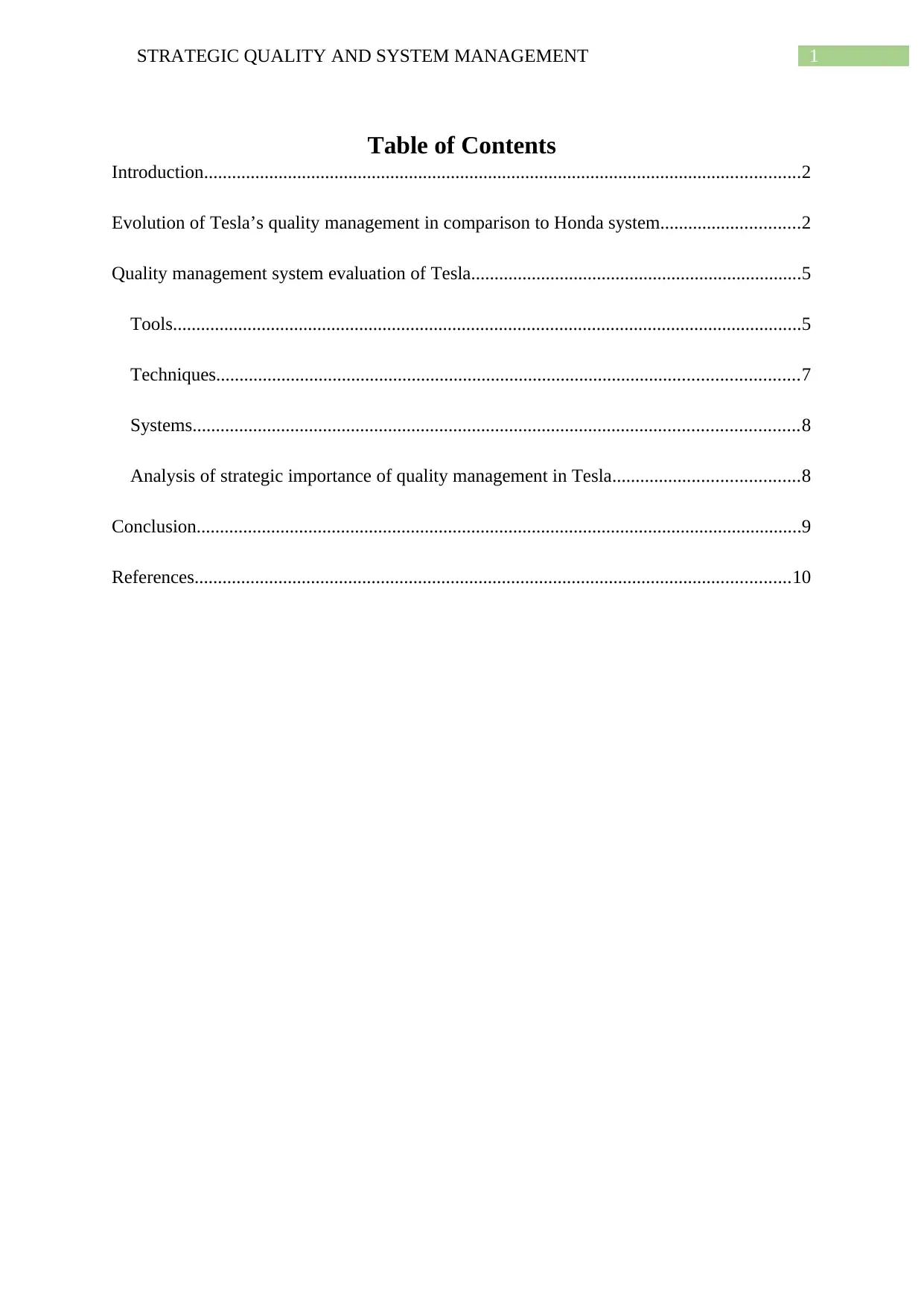
1STRATEGIC QUALITY AND SYSTEM MANAGEMENT
Table of Contents
Introduction................................................................................................................................2
Evolution of Tesla’s quality management in comparison to Honda system..............................2
Quality management system evaluation of Tesla.......................................................................5
Tools.......................................................................................................................................5
Techniques.............................................................................................................................7
Systems..................................................................................................................................8
Analysis of strategic importance of quality management in Tesla........................................8
Conclusion..................................................................................................................................9
References................................................................................................................................10
Table of Contents
Introduction................................................................................................................................2
Evolution of Tesla’s quality management in comparison to Honda system..............................2
Quality management system evaluation of Tesla.......................................................................5
Tools.......................................................................................................................................5
Techniques.............................................................................................................................7
Systems..................................................................................................................................8
Analysis of strategic importance of quality management in Tesla........................................8
Conclusion..................................................................................................................................9
References................................................................................................................................10
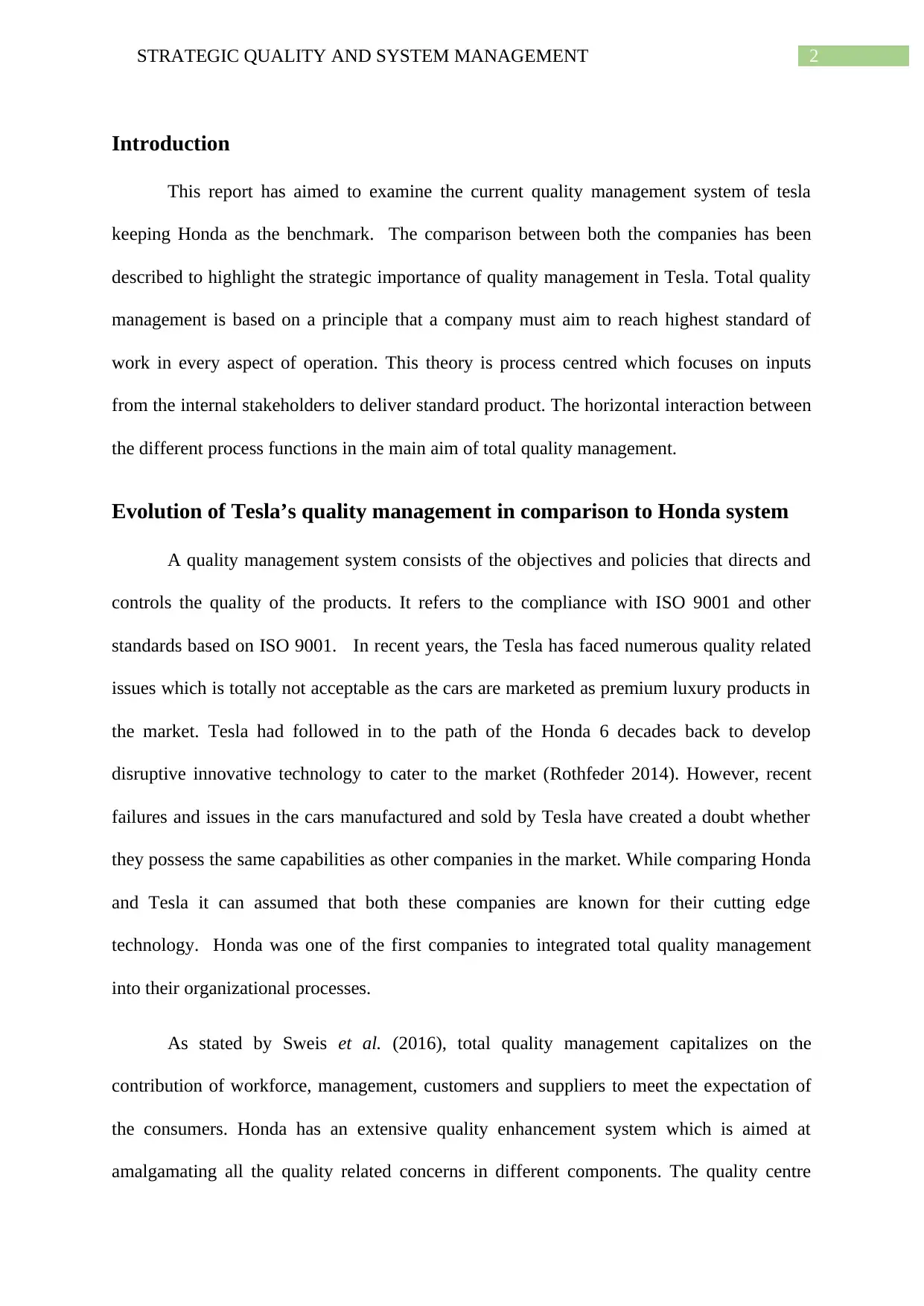
2STRATEGIC QUALITY AND SYSTEM MANAGEMENT
Introduction
This report has aimed to examine the current quality management system of tesla
keeping Honda as the benchmark. The comparison between both the companies has been
described to highlight the strategic importance of quality management in Tesla. Total quality
management is based on a principle that a company must aim to reach highest standard of
work in every aspect of operation. This theory is process centred which focuses on inputs
from the internal stakeholders to deliver standard product. The horizontal interaction between
the different process functions in the main aim of total quality management.
Evolution of Tesla’s quality management in comparison to Honda system
A quality management system consists of the objectives and policies that directs and
controls the quality of the products. It refers to the compliance with ISO 9001 and other
standards based on ISO 9001. In recent years, the Tesla has faced numerous quality related
issues which is totally not acceptable as the cars are marketed as premium luxury products in
the market. Tesla had followed in to the path of the Honda 6 decades back to develop
disruptive innovative technology to cater to the market (Rothfeder 2014). However, recent
failures and issues in the cars manufactured and sold by Tesla have created a doubt whether
they possess the same capabilities as other companies in the market. While comparing Honda
and Tesla it can assumed that both these companies are known for their cutting edge
technology. Honda was one of the first companies to integrated total quality management
into their organizational processes.
As stated by Sweis et al. (2016), total quality management capitalizes on the
contribution of workforce, management, customers and suppliers to meet the expectation of
the consumers. Honda has an extensive quality enhancement system which is aimed at
amalgamating all the quality related concerns in different components. The quality centre
Introduction
This report has aimed to examine the current quality management system of tesla
keeping Honda as the benchmark. The comparison between both the companies has been
described to highlight the strategic importance of quality management in Tesla. Total quality
management is based on a principle that a company must aim to reach highest standard of
work in every aspect of operation. This theory is process centred which focuses on inputs
from the internal stakeholders to deliver standard product. The horizontal interaction between
the different process functions in the main aim of total quality management.
Evolution of Tesla’s quality management in comparison to Honda system
A quality management system consists of the objectives and policies that directs and
controls the quality of the products. It refers to the compliance with ISO 9001 and other
standards based on ISO 9001. In recent years, the Tesla has faced numerous quality related
issues which is totally not acceptable as the cars are marketed as premium luxury products in
the market. Tesla had followed in to the path of the Honda 6 decades back to develop
disruptive innovative technology to cater to the market (Rothfeder 2014). However, recent
failures and issues in the cars manufactured and sold by Tesla have created a doubt whether
they possess the same capabilities as other companies in the market. While comparing Honda
and Tesla it can assumed that both these companies are known for their cutting edge
technology. Honda was one of the first companies to integrated total quality management
into their organizational processes.
As stated by Sweis et al. (2016), total quality management capitalizes on the
contribution of workforce, management, customers and suppliers to meet the expectation of
the consumers. Honda has an extensive quality enhancement system which is aimed at
amalgamating all the quality related concerns in different components. The quality centre
⊘ This is a preview!⊘
Do you want full access?
Subscribe today to unlock all pages.

Trusted by 1+ million students worldwide
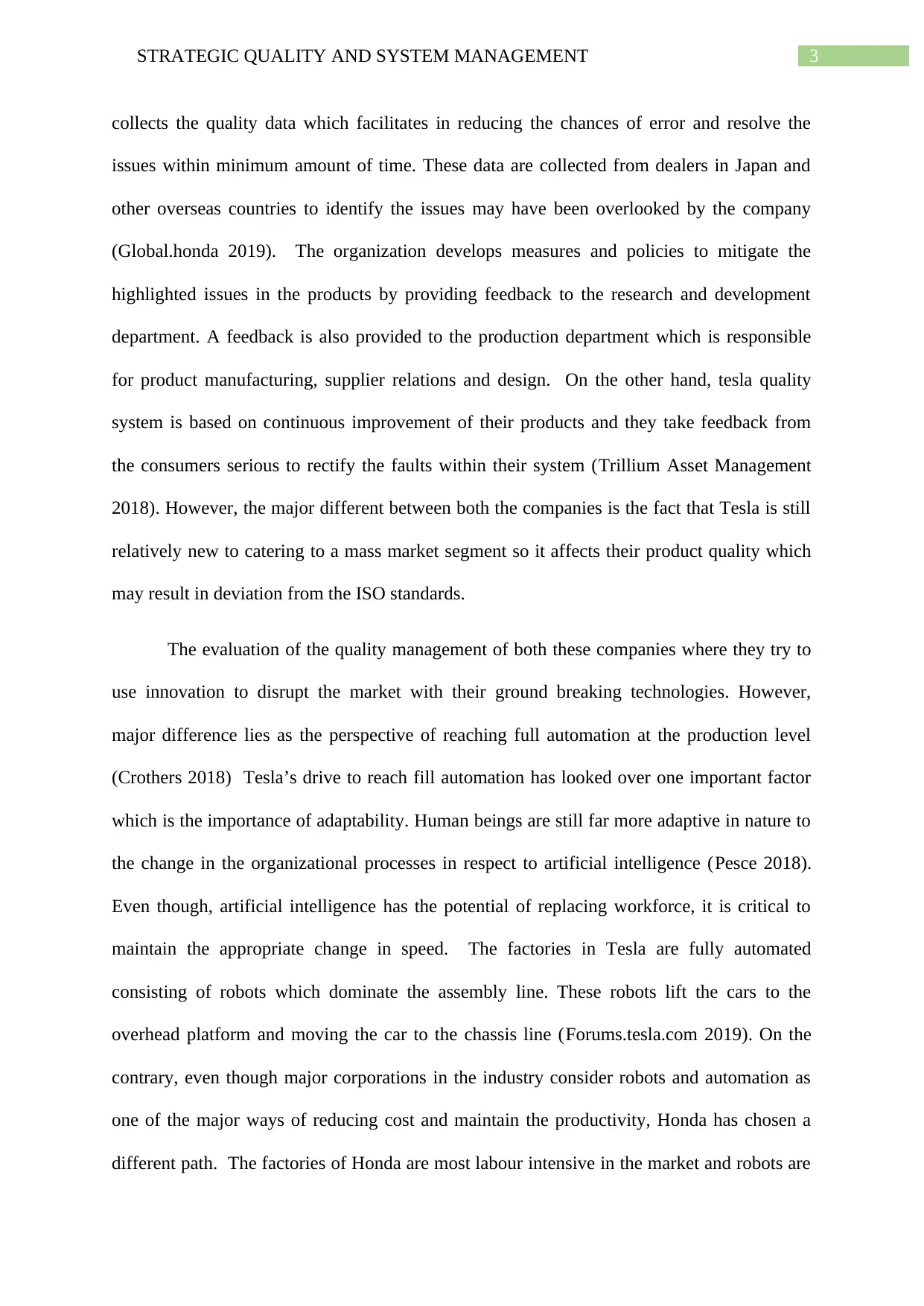
3STRATEGIC QUALITY AND SYSTEM MANAGEMENT
collects the quality data which facilitates in reducing the chances of error and resolve the
issues within minimum amount of time. These data are collected from dealers in Japan and
other overseas countries to identify the issues may have been overlooked by the company
(Global.honda 2019). The organization develops measures and policies to mitigate the
highlighted issues in the products by providing feedback to the research and development
department. A feedback is also provided to the production department which is responsible
for product manufacturing, supplier relations and design. On the other hand, tesla quality
system is based on continuous improvement of their products and they take feedback from
the consumers serious to rectify the faults within their system (Trillium Asset Management
2018). However, the major different between both the companies is the fact that Tesla is still
relatively new to catering to a mass market segment so it affects their product quality which
may result in deviation from the ISO standards.
The evaluation of the quality management of both these companies where they try to
use innovation to disrupt the market with their ground breaking technologies. However,
major difference lies as the perspective of reaching full automation at the production level
(Crothers 2018) Tesla’s drive to reach fill automation has looked over one important factor
which is the importance of adaptability. Human beings are still far more adaptive in nature to
the change in the organizational processes in respect to artificial intelligence (Pesce 2018).
Even though, artificial intelligence has the potential of replacing workforce, it is critical to
maintain the appropriate change in speed. The factories in Tesla are fully automated
consisting of robots which dominate the assembly line. These robots lift the cars to the
overhead platform and moving the car to the chassis line (Forums.tesla.com 2019). On the
contrary, even though major corporations in the industry consider robots and automation as
one of the major ways of reducing cost and maintain the productivity, Honda has chosen a
different path. The factories of Honda are most labour intensive in the market and robots are
collects the quality data which facilitates in reducing the chances of error and resolve the
issues within minimum amount of time. These data are collected from dealers in Japan and
other overseas countries to identify the issues may have been overlooked by the company
(Global.honda 2019). The organization develops measures and policies to mitigate the
highlighted issues in the products by providing feedback to the research and development
department. A feedback is also provided to the production department which is responsible
for product manufacturing, supplier relations and design. On the other hand, tesla quality
system is based on continuous improvement of their products and they take feedback from
the consumers serious to rectify the faults within their system (Trillium Asset Management
2018). However, the major different between both the companies is the fact that Tesla is still
relatively new to catering to a mass market segment so it affects their product quality which
may result in deviation from the ISO standards.
The evaluation of the quality management of both these companies where they try to
use innovation to disrupt the market with their ground breaking technologies. However,
major difference lies as the perspective of reaching full automation at the production level
(Crothers 2018) Tesla’s drive to reach fill automation has looked over one important factor
which is the importance of adaptability. Human beings are still far more adaptive in nature to
the change in the organizational processes in respect to artificial intelligence (Pesce 2018).
Even though, artificial intelligence has the potential of replacing workforce, it is critical to
maintain the appropriate change in speed. The factories in Tesla are fully automated
consisting of robots which dominate the assembly line. These robots lift the cars to the
overhead platform and moving the car to the chassis line (Forums.tesla.com 2019). On the
contrary, even though major corporations in the industry consider robots and automation as
one of the major ways of reducing cost and maintain the productivity, Honda has chosen a
different path. The factories of Honda are most labour intensive in the market and robots are
Paraphrase This Document
Need a fresh take? Get an instant paraphrase of this document with our AI Paraphraser

4STRATEGIC QUALITY AND SYSTEM MANAGEMENT
employed in areas that are dangerous and less fit for human roles. Honda believes that their
assemblers become disengaged and local innovation is muted by the presence of automated
machines where the main purpose is developing cars at a faster and cheaper rate (Rothfeder
2014). The quality and output standards are set to a level which can reached only by
automation but it compromises the boundless creativity which can be achieved through
human imagination and involvement. As per the philosophy of Honda, automation results in
lack of innovation and saturation of improvement within the organization process.
Therefore, it can be stated that the philosophies of both the companies is completely
different even though both aims to achieve superior quality management through continuous
improvement. This results in vast differences in the quality of the products offered by each
of the companies. Even though, Tesla offers premium quality products to the consumers,
there are major finishing issues, primarily peeling, insufficient thickness and marring (Stumpf
2017). This shows that the company is facing problems with providing high quality finished
products to large market due to their lack of experience in catering to the mass market .
Honda’s emphasis on factory flexibility enables them to produce different products on a
single assembly line (Rothfeder 2014). This means that in term of competition and launching
of new products, Honda can develop a new product on the same assembly line but Tesla
would have to retool their assembly line to address the needs of the new product (Fosse
2019). This facilitates in addressing any issue within the assembly very swiftly and the
production volume and quality is not affected. Honda has been the pioneer in dealing with
these issues and deftly navigate the challenges they are faced with.
Therefore, this shows that in context to total quality management, Honda is still open
changes in comparison to the drive of Tesla of reaching automation and reducing their
production to cater to a larger market. This may result in downfall of the company as they are
not maintain the high standard of the products they offer to the consumers. Tesla charges
employed in areas that are dangerous and less fit for human roles. Honda believes that their
assemblers become disengaged and local innovation is muted by the presence of automated
machines where the main purpose is developing cars at a faster and cheaper rate (Rothfeder
2014). The quality and output standards are set to a level which can reached only by
automation but it compromises the boundless creativity which can be achieved through
human imagination and involvement. As per the philosophy of Honda, automation results in
lack of innovation and saturation of improvement within the organization process.
Therefore, it can be stated that the philosophies of both the companies is completely
different even though both aims to achieve superior quality management through continuous
improvement. This results in vast differences in the quality of the products offered by each
of the companies. Even though, Tesla offers premium quality products to the consumers,
there are major finishing issues, primarily peeling, insufficient thickness and marring (Stumpf
2017). This shows that the company is facing problems with providing high quality finished
products to large market due to their lack of experience in catering to the mass market .
Honda’s emphasis on factory flexibility enables them to produce different products on a
single assembly line (Rothfeder 2014). This means that in term of competition and launching
of new products, Honda can develop a new product on the same assembly line but Tesla
would have to retool their assembly line to address the needs of the new product (Fosse
2019). This facilitates in addressing any issue within the assembly very swiftly and the
production volume and quality is not affected. Honda has been the pioneer in dealing with
these issues and deftly navigate the challenges they are faced with.
Therefore, this shows that in context to total quality management, Honda is still open
changes in comparison to the drive of Tesla of reaching automation and reducing their
production to cater to a larger market. This may result in downfall of the company as they are
not maintain the high standard of the products they offer to the consumers. Tesla charges
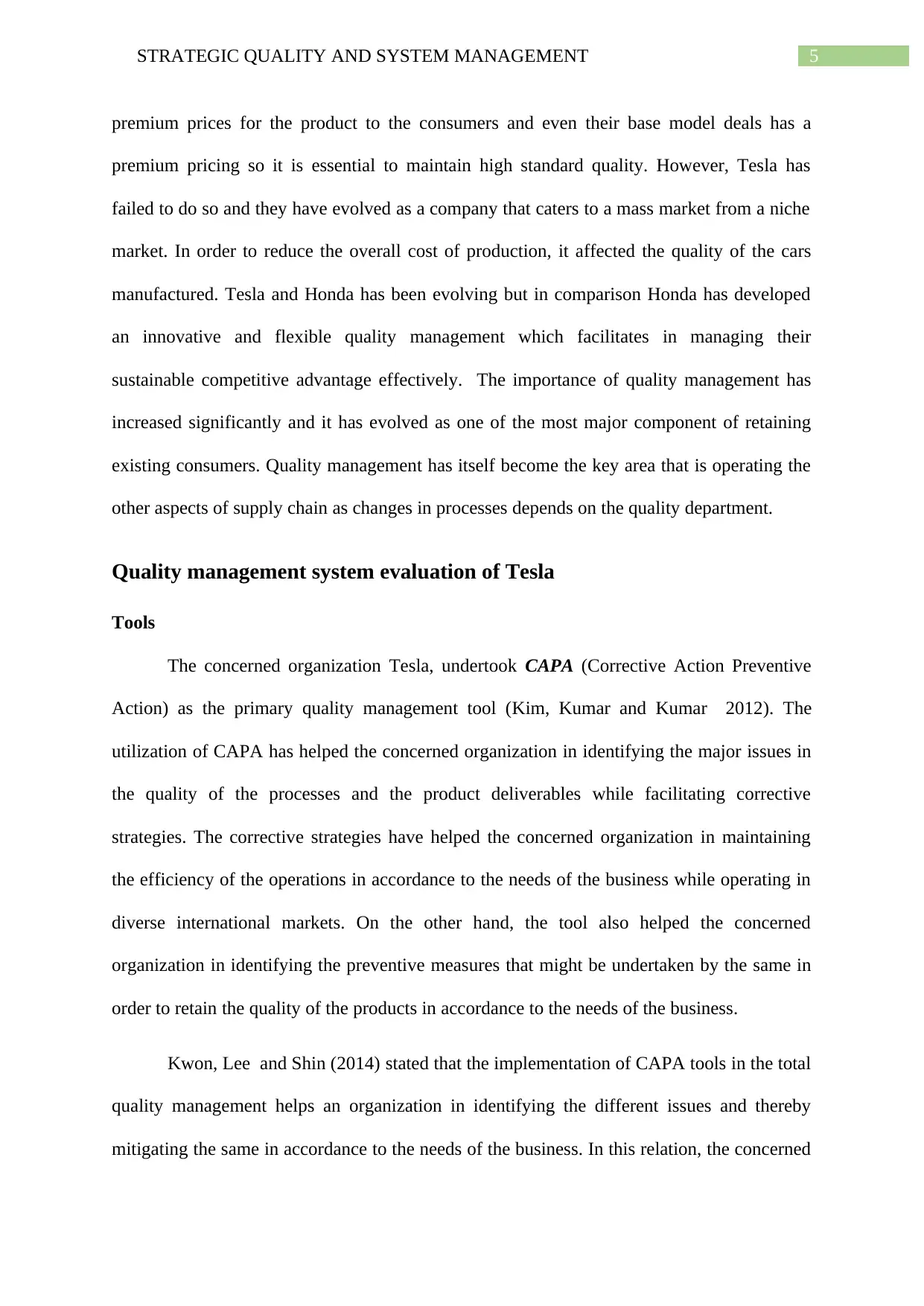
5STRATEGIC QUALITY AND SYSTEM MANAGEMENT
premium prices for the product to the consumers and even their base model deals has a
premium pricing so it is essential to maintain high standard quality. However, Tesla has
failed to do so and they have evolved as a company that caters to a mass market from a niche
market. In order to reduce the overall cost of production, it affected the quality of the cars
manufactured. Tesla and Honda has been evolving but in comparison Honda has developed
an innovative and flexible quality management which facilitates in managing their
sustainable competitive advantage effectively. The importance of quality management has
increased significantly and it has evolved as one of the most major component of retaining
existing consumers. Quality management has itself become the key area that is operating the
other aspects of supply chain as changes in processes depends on the quality department.
Quality management system evaluation of Tesla
Tools
The concerned organization Tesla, undertook CAPA (Corrective Action Preventive
Action) as the primary quality management tool (Kim, Kumar and Kumar 2012). The
utilization of CAPA has helped the concerned organization in identifying the major issues in
the quality of the processes and the product deliverables while facilitating corrective
strategies. The corrective strategies have helped the concerned organization in maintaining
the efficiency of the operations in accordance to the needs of the business while operating in
diverse international markets. On the other hand, the tool also helped the concerned
organization in identifying the preventive measures that might be undertaken by the same in
order to retain the quality of the products in accordance to the needs of the business.
Kwon, Lee and Shin (2014) stated that the implementation of CAPA tools in the total
quality management helps an organization in identifying the different issues and thereby
mitigating the same in accordance to the needs of the business. In this relation, the concerned
premium prices for the product to the consumers and even their base model deals has a
premium pricing so it is essential to maintain high standard quality. However, Tesla has
failed to do so and they have evolved as a company that caters to a mass market from a niche
market. In order to reduce the overall cost of production, it affected the quality of the cars
manufactured. Tesla and Honda has been evolving but in comparison Honda has developed
an innovative and flexible quality management which facilitates in managing their
sustainable competitive advantage effectively. The importance of quality management has
increased significantly and it has evolved as one of the most major component of retaining
existing consumers. Quality management has itself become the key area that is operating the
other aspects of supply chain as changes in processes depends on the quality department.
Quality management system evaluation of Tesla
Tools
The concerned organization Tesla, undertook CAPA (Corrective Action Preventive
Action) as the primary quality management tool (Kim, Kumar and Kumar 2012). The
utilization of CAPA has helped the concerned organization in identifying the major issues in
the quality of the processes and the product deliverables while facilitating corrective
strategies. The corrective strategies have helped the concerned organization in maintaining
the efficiency of the operations in accordance to the needs of the business while operating in
diverse international markets. On the other hand, the tool also helped the concerned
organization in identifying the preventive measures that might be undertaken by the same in
order to retain the quality of the products in accordance to the needs of the business.
Kwon, Lee and Shin (2014) stated that the implementation of CAPA tools in the total
quality management helps an organization in identifying the different issues and thereby
mitigating the same in accordance to the needs of the business. In this relation, the concerned
⊘ This is a preview!⊘
Do you want full access?
Subscribe today to unlock all pages.

Trusted by 1+ million students worldwide
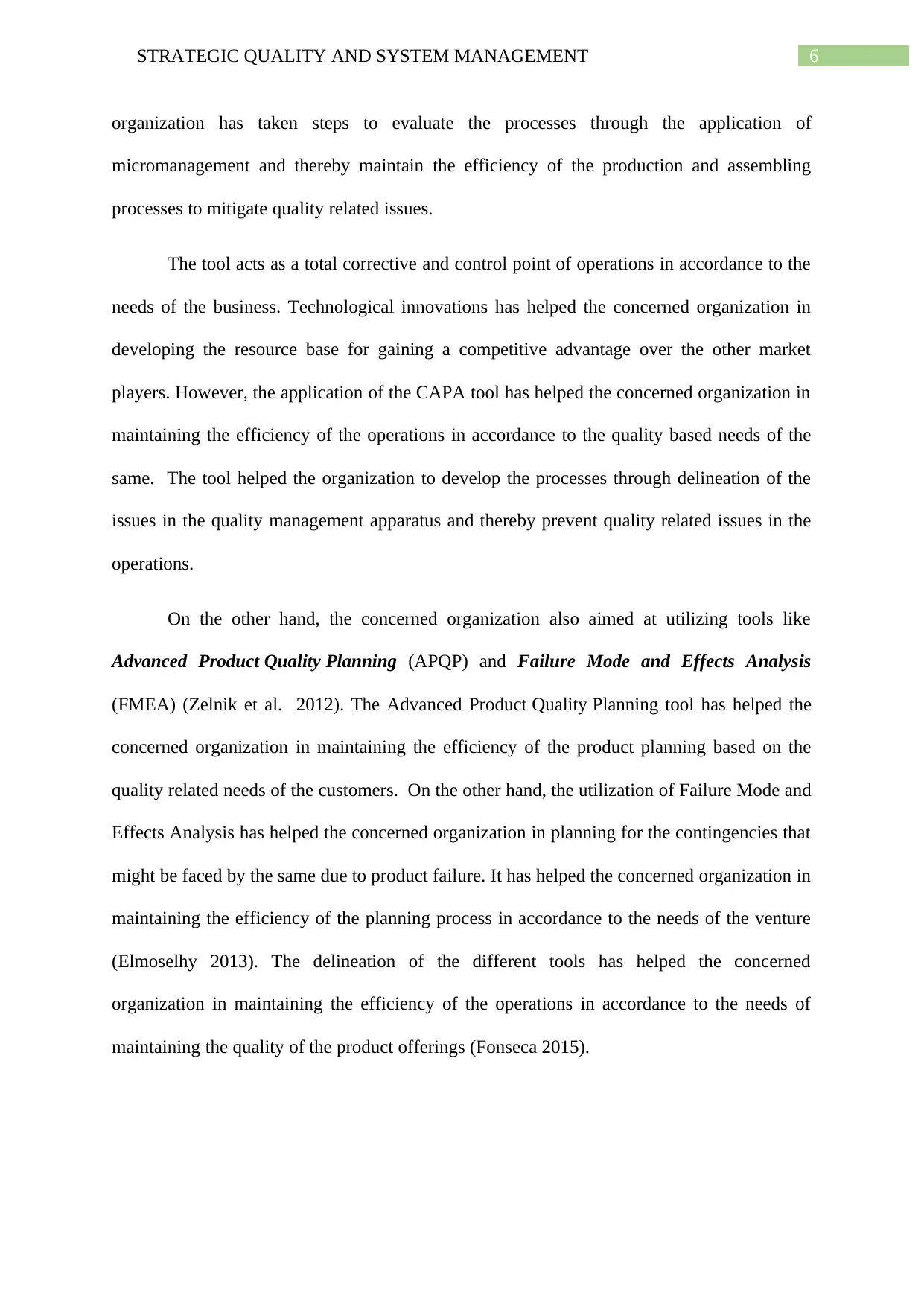
6STRATEGIC QUALITY AND SYSTEM MANAGEMENT
organization has taken steps to evaluate the processes through the application of
micromanagement and thereby maintain the efficiency of the production and assembling
processes to mitigate quality related issues.
The tool acts as a total corrective and control point of operations in accordance to the
needs of the business. Technological innovations has helped the concerned organization in
developing the resource base for gaining a competitive advantage over the other market
players. However, the application of the CAPA tool has helped the concerned organization in
maintaining the efficiency of the operations in accordance to the quality based needs of the
same. The tool helped the organization to develop the processes through delineation of the
issues in the quality management apparatus and thereby prevent quality related issues in the
operations.
On the other hand, the concerned organization also aimed at utilizing tools like
Advanced Product Quality Planning (APQP) and Failure Mode and Effects Analysis
(FMEA) (Zelnik et al. 2012). The Advanced Product Quality Planning tool has helped the
concerned organization in maintaining the efficiency of the product planning based on the
quality related needs of the customers. On the other hand, the utilization of Failure Mode and
Effects Analysis has helped the concerned organization in planning for the contingencies that
might be faced by the same due to product failure. It has helped the concerned organization in
maintaining the efficiency of the planning process in accordance to the needs of the venture
(Elmoselhy 2013). The delineation of the different tools has helped the concerned
organization in maintaining the efficiency of the operations in accordance to the needs of
maintaining the quality of the product offerings (Fonseca 2015).
organization has taken steps to evaluate the processes through the application of
micromanagement and thereby maintain the efficiency of the production and assembling
processes to mitigate quality related issues.
The tool acts as a total corrective and control point of operations in accordance to the
needs of the business. Technological innovations has helped the concerned organization in
developing the resource base for gaining a competitive advantage over the other market
players. However, the application of the CAPA tool has helped the concerned organization in
maintaining the efficiency of the operations in accordance to the quality based needs of the
same. The tool helped the organization to develop the processes through delineation of the
issues in the quality management apparatus and thereby prevent quality related issues in the
operations.
On the other hand, the concerned organization also aimed at utilizing tools like
Advanced Product Quality Planning (APQP) and Failure Mode and Effects Analysis
(FMEA) (Zelnik et al. 2012). The Advanced Product Quality Planning tool has helped the
concerned organization in maintaining the efficiency of the product planning based on the
quality related needs of the customers. On the other hand, the utilization of Failure Mode and
Effects Analysis has helped the concerned organization in planning for the contingencies that
might be faced by the same due to product failure. It has helped the concerned organization in
maintaining the efficiency of the planning process in accordance to the needs of the venture
(Elmoselhy 2013). The delineation of the different tools has helped the concerned
organization in maintaining the efficiency of the operations in accordance to the needs of
maintaining the quality of the product offerings (Fonseca 2015).
Paraphrase This Document
Need a fresh take? Get an instant paraphrase of this document with our AI Paraphraser
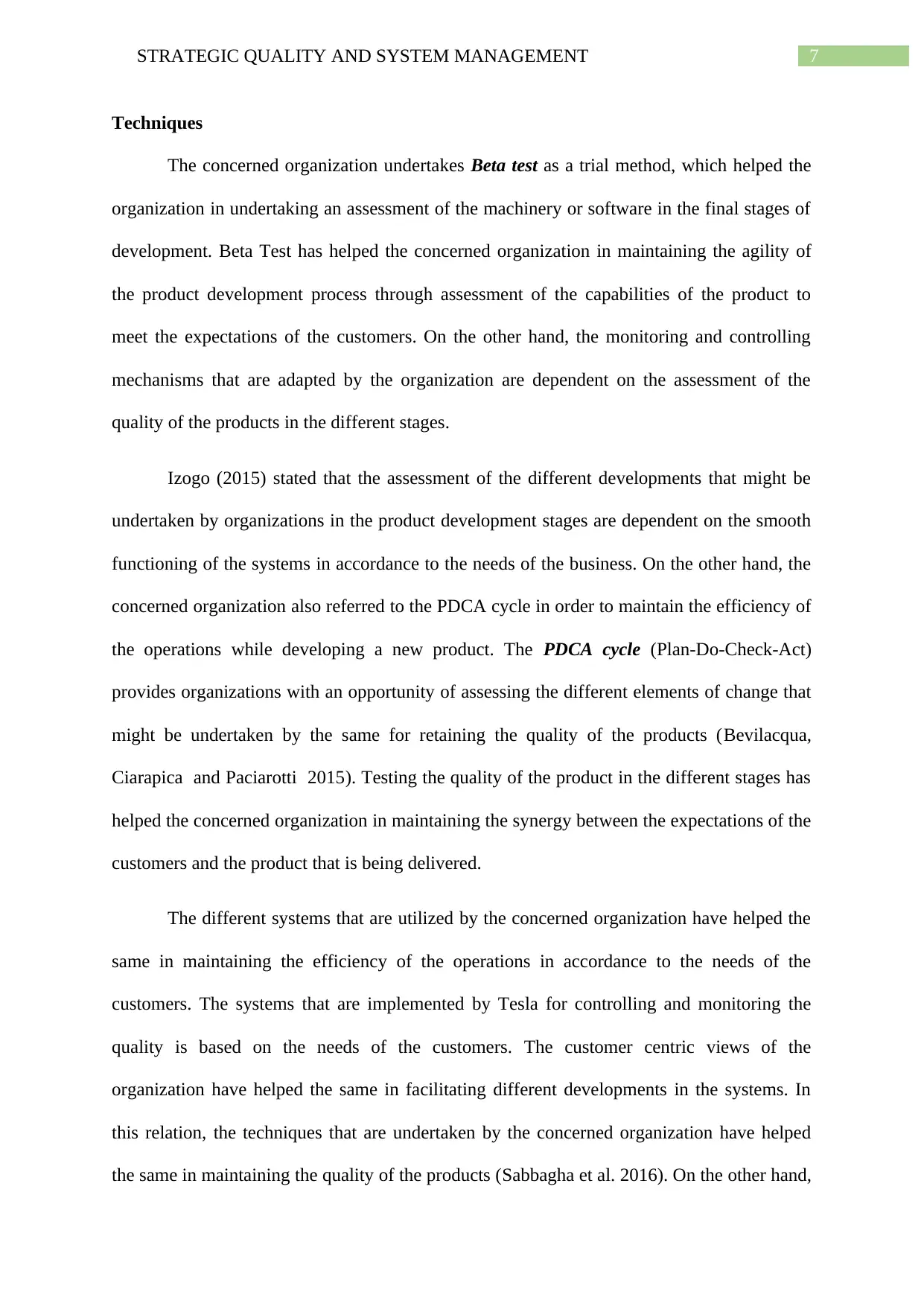
7STRATEGIC QUALITY AND SYSTEM MANAGEMENT
Techniques
The concerned organization undertakes Beta test as a trial method, which helped the
organization in undertaking an assessment of the machinery or software in the final stages of
development. Beta Test has helped the concerned organization in maintaining the agility of
the product development process through assessment of the capabilities of the product to
meet the expectations of the customers. On the other hand, the monitoring and controlling
mechanisms that are adapted by the organization are dependent on the assessment of the
quality of the products in the different stages.
Izogo (2015) stated that the assessment of the different developments that might be
undertaken by organizations in the product development stages are dependent on the smooth
functioning of the systems in accordance to the needs of the business. On the other hand, the
concerned organization also referred to the PDCA cycle in order to maintain the efficiency of
the operations while developing a new product. The PDCA cycle (Plan-Do-Check-Act)
provides organizations with an opportunity of assessing the different elements of change that
might be undertaken by the same for retaining the quality of the products (Bevilacqua,
Ciarapica and Paciarotti 2015). Testing the quality of the product in the different stages has
helped the concerned organization in maintaining the synergy between the expectations of the
customers and the product that is being delivered.
The different systems that are utilized by the concerned organization have helped the
same in maintaining the efficiency of the operations in accordance to the needs of the
customers. The systems that are implemented by Tesla for controlling and monitoring the
quality is based on the needs of the customers. The customer centric views of the
organization have helped the same in facilitating different developments in the systems. In
this relation, the techniques that are undertaken by the concerned organization have helped
the same in maintaining the quality of the products (Sabbagha et al. 2016). On the other hand,
Techniques
The concerned organization undertakes Beta test as a trial method, which helped the
organization in undertaking an assessment of the machinery or software in the final stages of
development. Beta Test has helped the concerned organization in maintaining the agility of
the product development process through assessment of the capabilities of the product to
meet the expectations of the customers. On the other hand, the monitoring and controlling
mechanisms that are adapted by the organization are dependent on the assessment of the
quality of the products in the different stages.
Izogo (2015) stated that the assessment of the different developments that might be
undertaken by organizations in the product development stages are dependent on the smooth
functioning of the systems in accordance to the needs of the business. On the other hand, the
concerned organization also referred to the PDCA cycle in order to maintain the efficiency of
the operations while developing a new product. The PDCA cycle (Plan-Do-Check-Act)
provides organizations with an opportunity of assessing the different elements of change that
might be undertaken by the same for retaining the quality of the products (Bevilacqua,
Ciarapica and Paciarotti 2015). Testing the quality of the product in the different stages has
helped the concerned organization in maintaining the synergy between the expectations of the
customers and the product that is being delivered.
The different systems that are utilized by the concerned organization have helped the
same in maintaining the efficiency of the operations in accordance to the needs of the
customers. The systems that are implemented by Tesla for controlling and monitoring the
quality is based on the needs of the customers. The customer centric views of the
organization have helped the same in facilitating different developments in the systems. In
this relation, the techniques that are undertaken by the concerned organization have helped
the same in maintaining the quality of the products (Sabbagha et al. 2016). On the other hand,
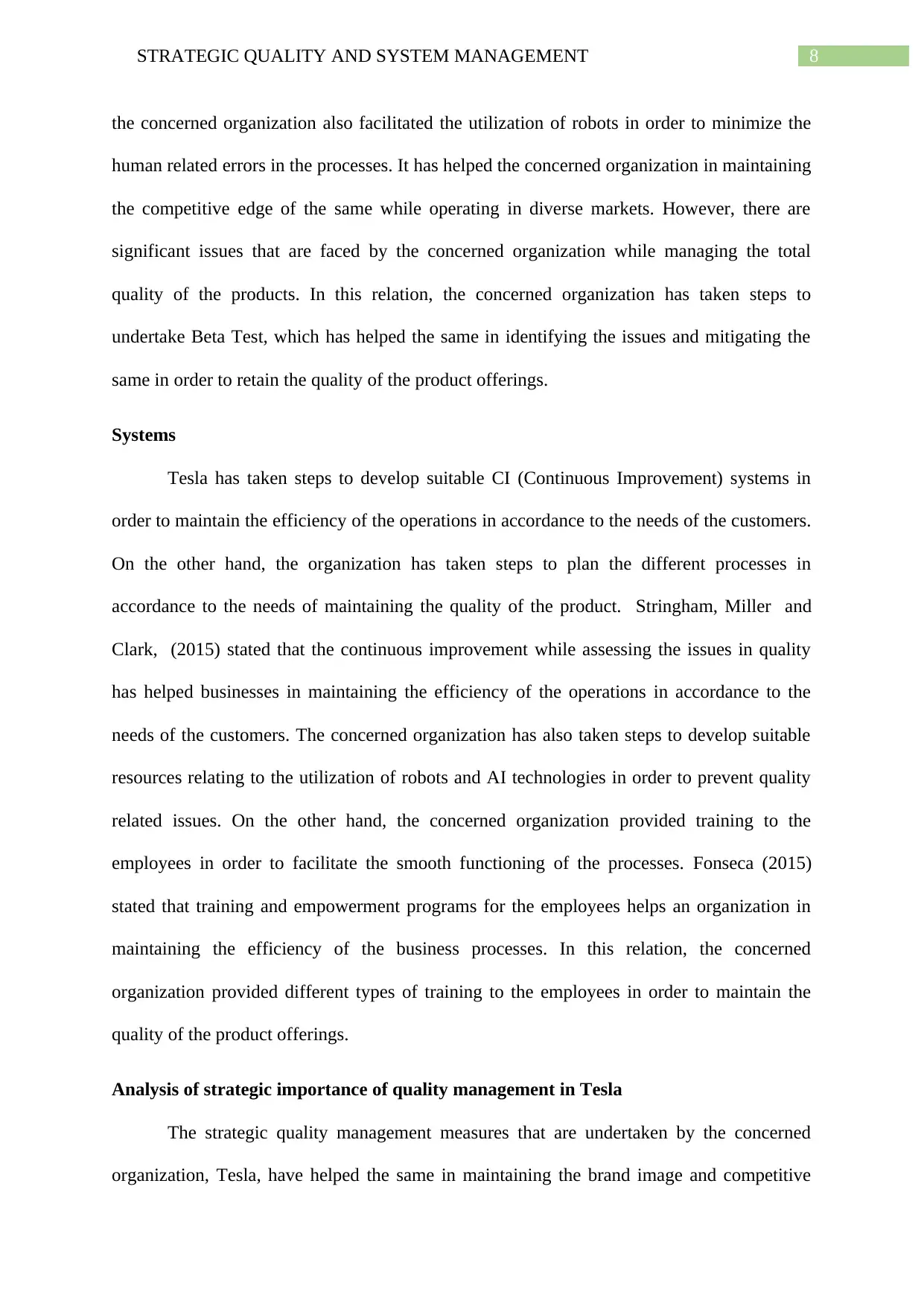
8STRATEGIC QUALITY AND SYSTEM MANAGEMENT
the concerned organization also facilitated the utilization of robots in order to minimize the
human related errors in the processes. It has helped the concerned organization in maintaining
the competitive edge of the same while operating in diverse markets. However, there are
significant issues that are faced by the concerned organization while managing the total
quality of the products. In this relation, the concerned organization has taken steps to
undertake Beta Test, which has helped the same in identifying the issues and mitigating the
same in order to retain the quality of the product offerings.
Systems
Tesla has taken steps to develop suitable CI (Continuous Improvement) systems in
order to maintain the efficiency of the operations in accordance to the needs of the customers.
On the other hand, the organization has taken steps to plan the different processes in
accordance to the needs of maintaining the quality of the product. Stringham, Miller and
Clark, (2015) stated that the continuous improvement while assessing the issues in quality
has helped businesses in maintaining the efficiency of the operations in accordance to the
needs of the customers. The concerned organization has also taken steps to develop suitable
resources relating to the utilization of robots and AI technologies in order to prevent quality
related issues. On the other hand, the concerned organization provided training to the
employees in order to facilitate the smooth functioning of the processes. Fonseca (2015)
stated that training and empowerment programs for the employees helps an organization in
maintaining the efficiency of the business processes. In this relation, the concerned
organization provided different types of training to the employees in order to maintain the
quality of the product offerings.
Analysis of strategic importance of quality management in Tesla
The strategic quality management measures that are undertaken by the concerned
organization, Tesla, have helped the same in maintaining the brand image and competitive
the concerned organization also facilitated the utilization of robots in order to minimize the
human related errors in the processes. It has helped the concerned organization in maintaining
the competitive edge of the same while operating in diverse markets. However, there are
significant issues that are faced by the concerned organization while managing the total
quality of the products. In this relation, the concerned organization has taken steps to
undertake Beta Test, which has helped the same in identifying the issues and mitigating the
same in order to retain the quality of the product offerings.
Systems
Tesla has taken steps to develop suitable CI (Continuous Improvement) systems in
order to maintain the efficiency of the operations in accordance to the needs of the customers.
On the other hand, the organization has taken steps to plan the different processes in
accordance to the needs of maintaining the quality of the product. Stringham, Miller and
Clark, (2015) stated that the continuous improvement while assessing the issues in quality
has helped businesses in maintaining the efficiency of the operations in accordance to the
needs of the customers. The concerned organization has also taken steps to develop suitable
resources relating to the utilization of robots and AI technologies in order to prevent quality
related issues. On the other hand, the concerned organization provided training to the
employees in order to facilitate the smooth functioning of the processes. Fonseca (2015)
stated that training and empowerment programs for the employees helps an organization in
maintaining the efficiency of the business processes. In this relation, the concerned
organization provided different types of training to the employees in order to maintain the
quality of the product offerings.
Analysis of strategic importance of quality management in Tesla
The strategic quality management measures that are undertaken by the concerned
organization, Tesla, have helped the same in maintaining the brand image and competitive
⊘ This is a preview!⊘
Do you want full access?
Subscribe today to unlock all pages.

Trusted by 1+ million students worldwide
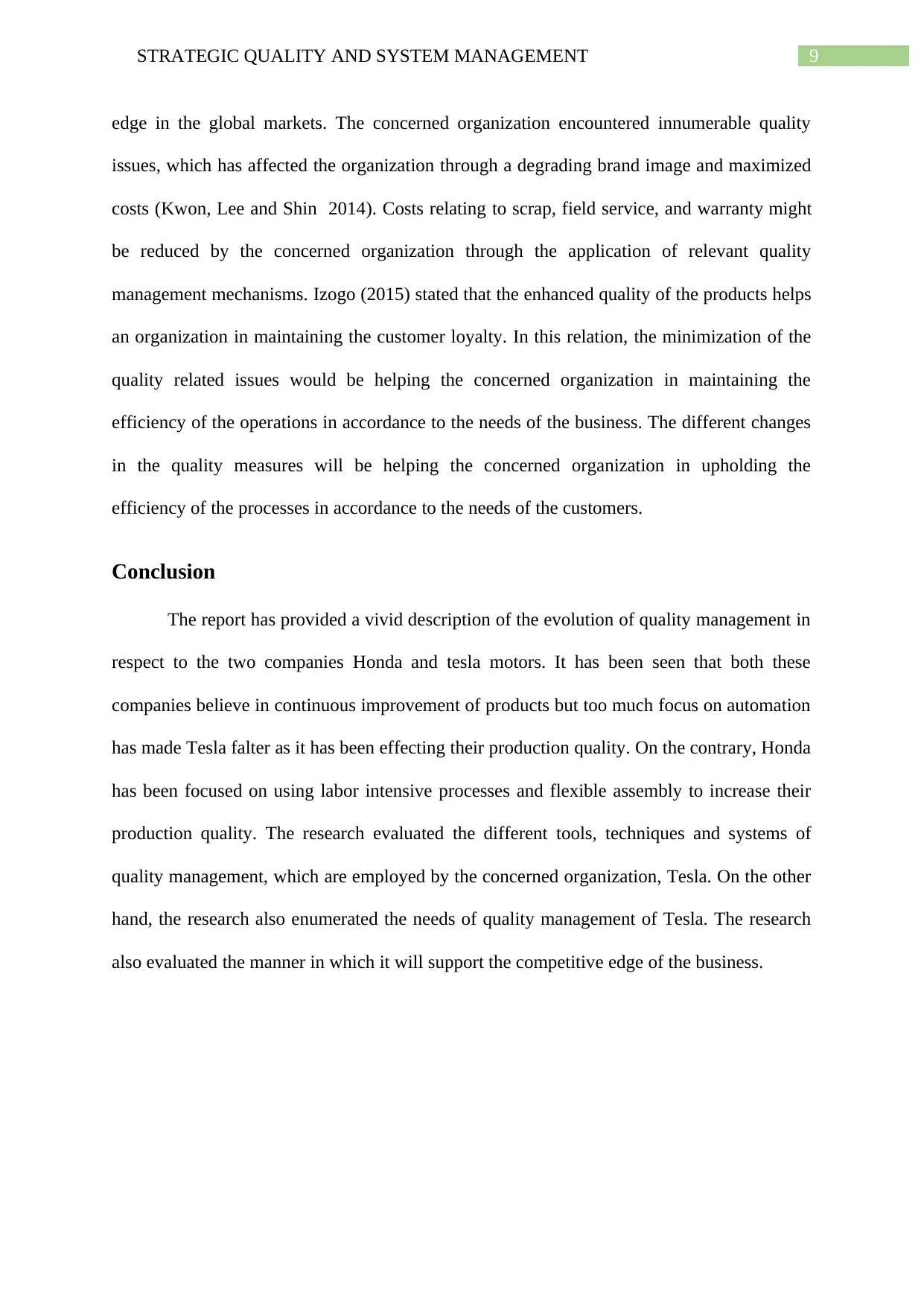
9STRATEGIC QUALITY AND SYSTEM MANAGEMENT
edge in the global markets. The concerned organization encountered innumerable quality
issues, which has affected the organization through a degrading brand image and maximized
costs (Kwon, Lee and Shin 2014). Costs relating to scrap, field service, and warranty might
be reduced by the concerned organization through the application of relevant quality
management mechanisms. Izogo (2015) stated that the enhanced quality of the products helps
an organization in maintaining the customer loyalty. In this relation, the minimization of the
quality related issues would be helping the concerned organization in maintaining the
efficiency of the operations in accordance to the needs of the business. The different changes
in the quality measures will be helping the concerned organization in upholding the
efficiency of the processes in accordance to the needs of the customers.
Conclusion
The report has provided a vivid description of the evolution of quality management in
respect to the two companies Honda and tesla motors. It has been seen that both these
companies believe in continuous improvement of products but too much focus on automation
has made Tesla falter as it has been effecting their production quality. On the contrary, Honda
has been focused on using labor intensive processes and flexible assembly to increase their
production quality. The research evaluated the different tools, techniques and systems of
quality management, which are employed by the concerned organization, Tesla. On the other
hand, the research also enumerated the needs of quality management of Tesla. The research
also evaluated the manner in which it will support the competitive edge of the business.
edge in the global markets. The concerned organization encountered innumerable quality
issues, which has affected the organization through a degrading brand image and maximized
costs (Kwon, Lee and Shin 2014). Costs relating to scrap, field service, and warranty might
be reduced by the concerned organization through the application of relevant quality
management mechanisms. Izogo (2015) stated that the enhanced quality of the products helps
an organization in maintaining the customer loyalty. In this relation, the minimization of the
quality related issues would be helping the concerned organization in maintaining the
efficiency of the operations in accordance to the needs of the business. The different changes
in the quality measures will be helping the concerned organization in upholding the
efficiency of the processes in accordance to the needs of the customers.
Conclusion
The report has provided a vivid description of the evolution of quality management in
respect to the two companies Honda and tesla motors. It has been seen that both these
companies believe in continuous improvement of products but too much focus on automation
has made Tesla falter as it has been effecting their production quality. On the contrary, Honda
has been focused on using labor intensive processes and flexible assembly to increase their
production quality. The research evaluated the different tools, techniques and systems of
quality management, which are employed by the concerned organization, Tesla. On the other
hand, the research also enumerated the needs of quality management of Tesla. The research
also evaluated the manner in which it will support the competitive edge of the business.
Paraphrase This Document
Need a fresh take? Get an instant paraphrase of this document with our AI Paraphraser
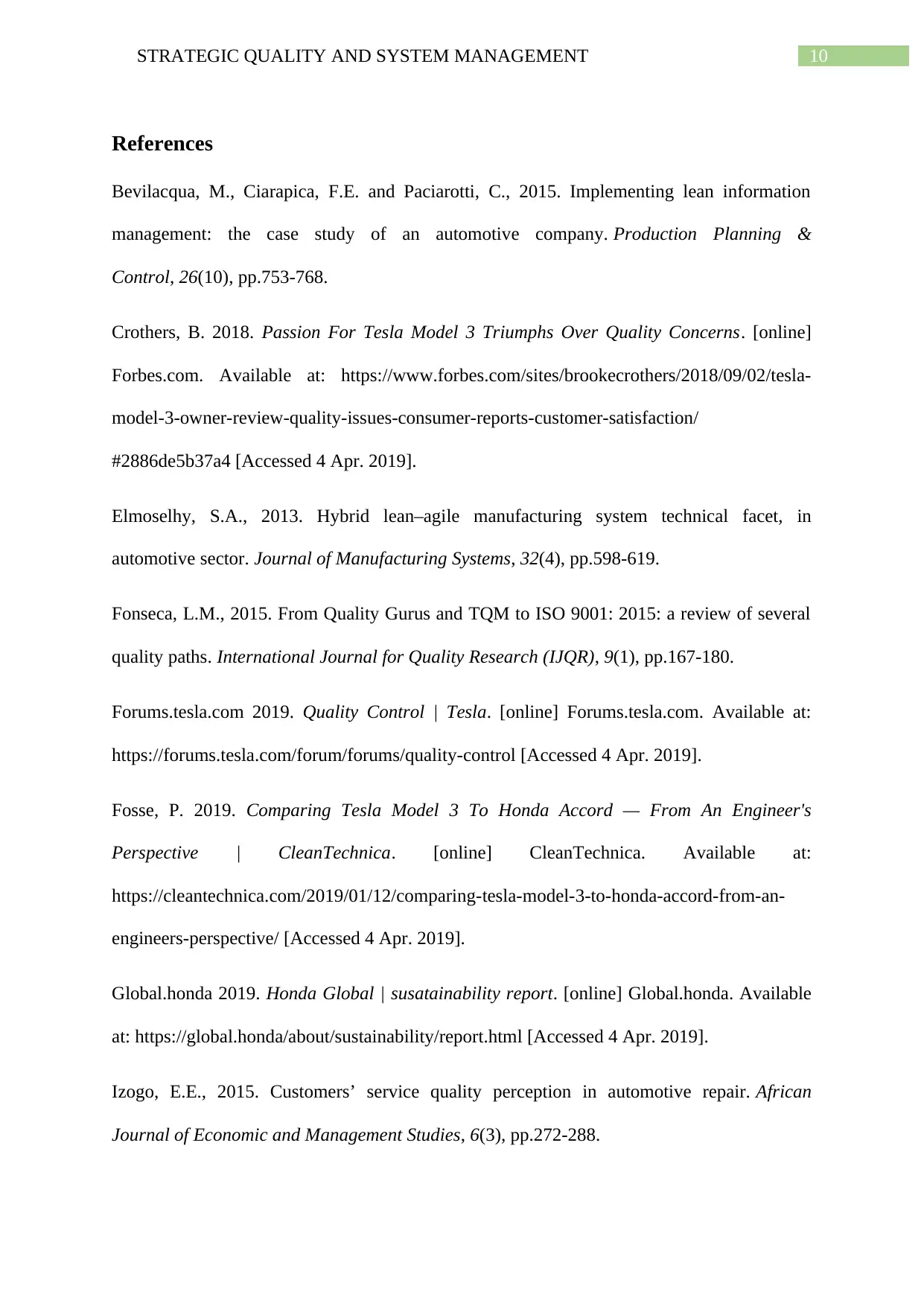
10STRATEGIC QUALITY AND SYSTEM MANAGEMENT
References
Bevilacqua, M., Ciarapica, F.E. and Paciarotti, C., 2015. Implementing lean information
management: the case study of an automotive company. Production Planning &
Control, 26(10), pp.753-768.
Crothers, B. 2018. Passion For Tesla Model 3 Triumphs Over Quality Concerns. [online]
Forbes.com. Available at: https://www.forbes.com/sites/brookecrothers/2018/09/02/tesla-
model-3-owner-review-quality-issues-consumer-reports-customer-satisfaction/
#2886de5b37a4 [Accessed 4 Apr. 2019].
Elmoselhy, S.A., 2013. Hybrid lean–agile manufacturing system technical facet, in
automotive sector. Journal of Manufacturing Systems, 32(4), pp.598-619.
Fonseca, L.M., 2015. From Quality Gurus and TQM to ISO 9001: 2015: a review of several
quality paths. International Journal for Quality Research (IJQR), 9(1), pp.167-180.
Forums.tesla.com 2019. Quality Control | Tesla. [online] Forums.tesla.com. Available at:
https://forums.tesla.com/forum/forums/quality-control [Accessed 4 Apr. 2019].
Fosse, P. 2019. Comparing Tesla Model 3 To Honda Accord — From An Engineer's
Perspective | CleanTechnica. [online] CleanTechnica. Available at:
https://cleantechnica.com/2019/01/12/comparing-tesla-model-3-to-honda-accord-from-an-
engineers-perspective/ [Accessed 4 Apr. 2019].
Global.honda 2019. Honda Global | susatainability report. [online] Global.honda. Available
at: https://global.honda/about/sustainability/report.html [Accessed 4 Apr. 2019].
Izogo, E.E., 2015. Customers’ service quality perception in automotive repair. African
Journal of Economic and Management Studies, 6(3), pp.272-288.
References
Bevilacqua, M., Ciarapica, F.E. and Paciarotti, C., 2015. Implementing lean information
management: the case study of an automotive company. Production Planning &
Control, 26(10), pp.753-768.
Crothers, B. 2018. Passion For Tesla Model 3 Triumphs Over Quality Concerns. [online]
Forbes.com. Available at: https://www.forbes.com/sites/brookecrothers/2018/09/02/tesla-
model-3-owner-review-quality-issues-consumer-reports-customer-satisfaction/
#2886de5b37a4 [Accessed 4 Apr. 2019].
Elmoselhy, S.A., 2013. Hybrid lean–agile manufacturing system technical facet, in
automotive sector. Journal of Manufacturing Systems, 32(4), pp.598-619.
Fonseca, L.M., 2015. From Quality Gurus and TQM to ISO 9001: 2015: a review of several
quality paths. International Journal for Quality Research (IJQR), 9(1), pp.167-180.
Forums.tesla.com 2019. Quality Control | Tesla. [online] Forums.tesla.com. Available at:
https://forums.tesla.com/forum/forums/quality-control [Accessed 4 Apr. 2019].
Fosse, P. 2019. Comparing Tesla Model 3 To Honda Accord — From An Engineer's
Perspective | CleanTechnica. [online] CleanTechnica. Available at:
https://cleantechnica.com/2019/01/12/comparing-tesla-model-3-to-honda-accord-from-an-
engineers-perspective/ [Accessed 4 Apr. 2019].
Global.honda 2019. Honda Global | susatainability report. [online] Global.honda. Available
at: https://global.honda/about/sustainability/report.html [Accessed 4 Apr. 2019].
Izogo, E.E., 2015. Customers’ service quality perception in automotive repair. African
Journal of Economic and Management Studies, 6(3), pp.272-288.
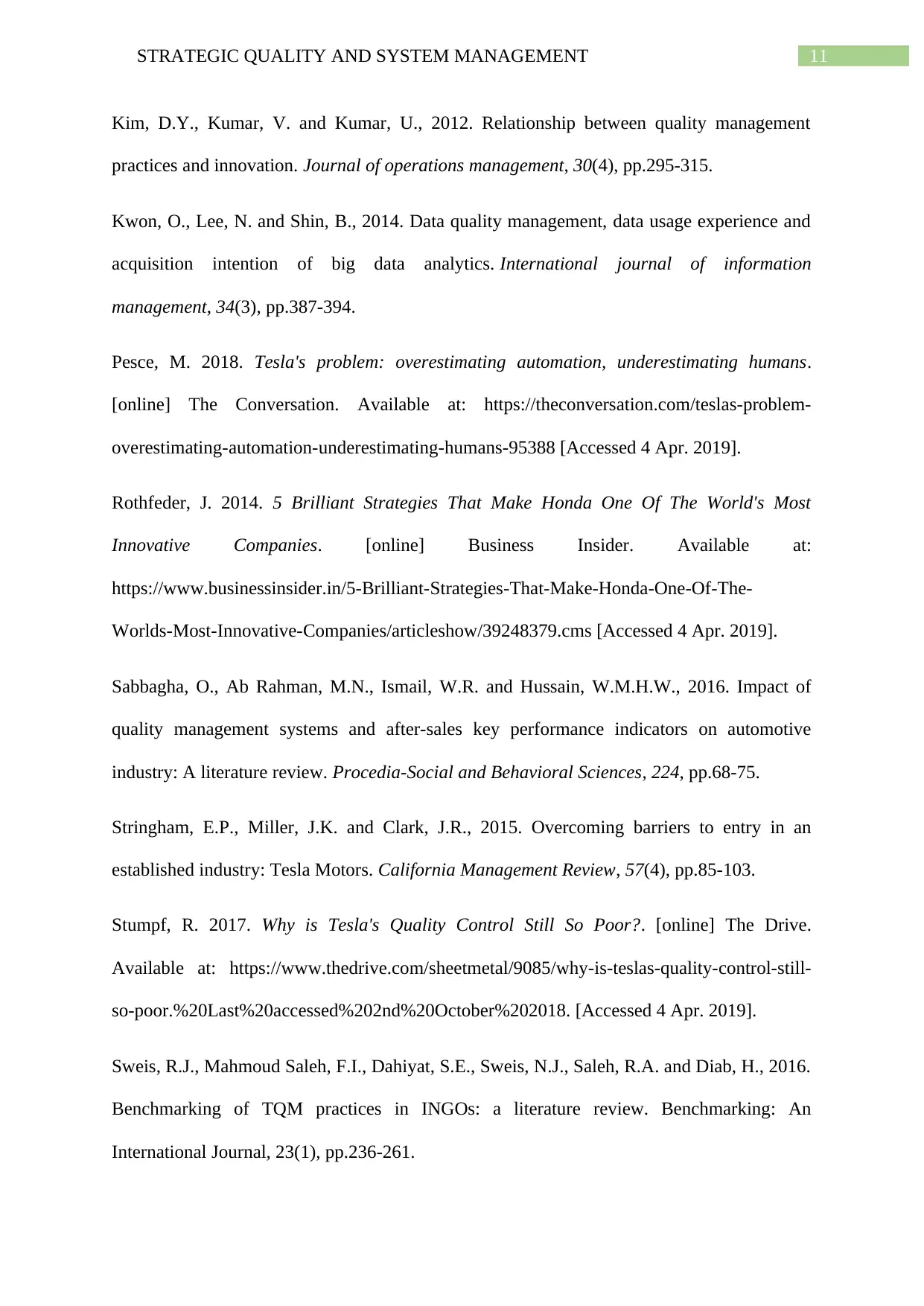
11STRATEGIC QUALITY AND SYSTEM MANAGEMENT
Kim, D.Y., Kumar, V. and Kumar, U., 2012. Relationship between quality management
practices and innovation. Journal of operations management, 30(4), pp.295-315.
Kwon, O., Lee, N. and Shin, B., 2014. Data quality management, data usage experience and
acquisition intention of big data analytics. International journal of information
management, 34(3), pp.387-394.
Pesce, M. 2018. Tesla's problem: overestimating automation, underestimating humans.
[online] The Conversation. Available at: https://theconversation.com/teslas-problem-
overestimating-automation-underestimating-humans-95388 [Accessed 4 Apr. 2019].
Rothfeder, J. 2014. 5 Brilliant Strategies That Make Honda One Of The World's Most
Innovative Companies. [online] Business Insider. Available at:
https://www.businessinsider.in/5-Brilliant-Strategies-That-Make-Honda-One-Of-The-
Worlds-Most-Innovative-Companies/articleshow/39248379.cms [Accessed 4 Apr. 2019].
Sabbagha, O., Ab Rahman, M.N., Ismail, W.R. and Hussain, W.M.H.W., 2016. Impact of
quality management systems and after-sales key performance indicators on automotive
industry: A literature review. Procedia-Social and Behavioral Sciences, 224, pp.68-75.
Stringham, E.P., Miller, J.K. and Clark, J.R., 2015. Overcoming barriers to entry in an
established industry: Tesla Motors. California Management Review, 57(4), pp.85-103.
Stumpf, R. 2017. Why is Tesla's Quality Control Still So Poor?. [online] The Drive.
Available at: https://www.thedrive.com/sheetmetal/9085/why-is-teslas-quality-control-still-
so-poor.%20Last%20accessed%202nd%20October%202018. [Accessed 4 Apr. 2019].
Sweis, R.J., Mahmoud Saleh, F.I., Dahiyat, S.E., Sweis, N.J., Saleh, R.A. and Diab, H., 2016.
Benchmarking of TQM practices in INGOs: a literature review. Benchmarking: An
International Journal, 23(1), pp.236-261.
Kim, D.Y., Kumar, V. and Kumar, U., 2012. Relationship between quality management
practices and innovation. Journal of operations management, 30(4), pp.295-315.
Kwon, O., Lee, N. and Shin, B., 2014. Data quality management, data usage experience and
acquisition intention of big data analytics. International journal of information
management, 34(3), pp.387-394.
Pesce, M. 2018. Tesla's problem: overestimating automation, underestimating humans.
[online] The Conversation. Available at: https://theconversation.com/teslas-problem-
overestimating-automation-underestimating-humans-95388 [Accessed 4 Apr. 2019].
Rothfeder, J. 2014. 5 Brilliant Strategies That Make Honda One Of The World's Most
Innovative Companies. [online] Business Insider. Available at:
https://www.businessinsider.in/5-Brilliant-Strategies-That-Make-Honda-One-Of-The-
Worlds-Most-Innovative-Companies/articleshow/39248379.cms [Accessed 4 Apr. 2019].
Sabbagha, O., Ab Rahman, M.N., Ismail, W.R. and Hussain, W.M.H.W., 2016. Impact of
quality management systems and after-sales key performance indicators on automotive
industry: A literature review. Procedia-Social and Behavioral Sciences, 224, pp.68-75.
Stringham, E.P., Miller, J.K. and Clark, J.R., 2015. Overcoming barriers to entry in an
established industry: Tesla Motors. California Management Review, 57(4), pp.85-103.
Stumpf, R. 2017. Why is Tesla's Quality Control Still So Poor?. [online] The Drive.
Available at: https://www.thedrive.com/sheetmetal/9085/why-is-teslas-quality-control-still-
so-poor.%20Last%20accessed%202nd%20October%202018. [Accessed 4 Apr. 2019].
Sweis, R.J., Mahmoud Saleh, F.I., Dahiyat, S.E., Sweis, N.J., Saleh, R.A. and Diab, H., 2016.
Benchmarking of TQM practices in INGOs: a literature review. Benchmarking: An
International Journal, 23(1), pp.236-261.
⊘ This is a preview!⊘
Do you want full access?
Subscribe today to unlock all pages.

Trusted by 1+ million students worldwide
1 out of 16
Related Documents
Your All-in-One AI-Powered Toolkit for Academic Success.
+13062052269
info@desklib.com
Available 24*7 on WhatsApp / Email
![[object Object]](/_next/static/media/star-bottom.7253800d.svg)
Unlock your academic potential
Copyright © 2020–2025 A2Z Services. All Rights Reserved. Developed and managed by ZUCOL.





